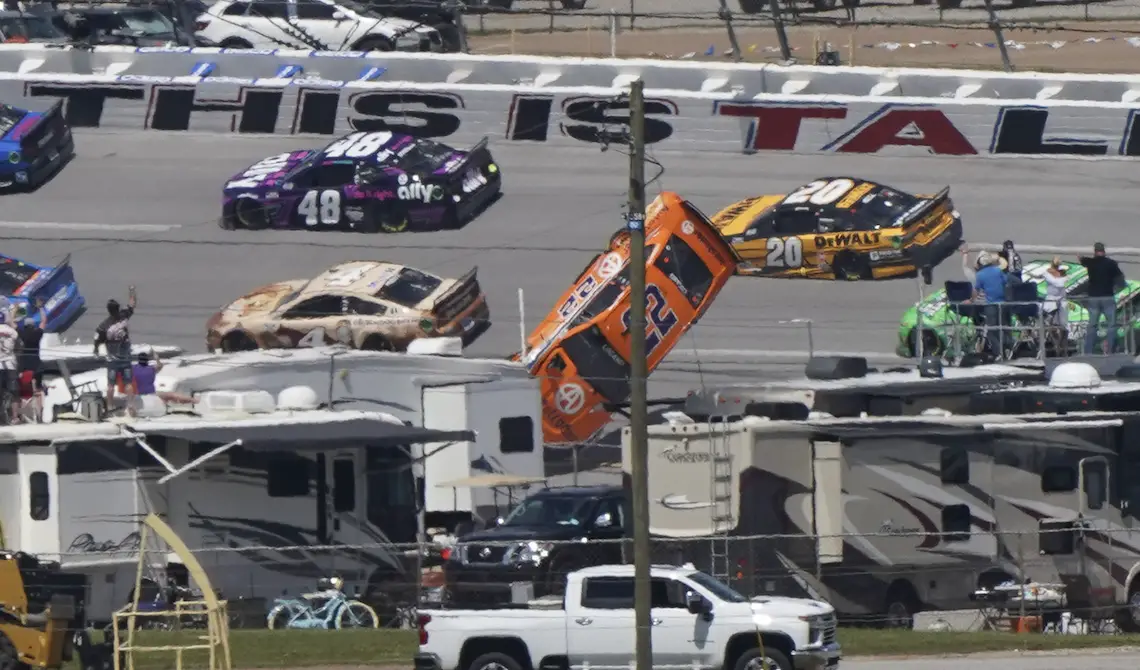
Marvin Gentry/USA TODAY Sports
NASCAR driver Joey Logano’s crash at Talladega on April 25 is creating a ripple effect in the motorsport’s rulebook.
With high speeds at play in the dangerous crash, officials have decided to revisit the regulations and make a few changes to increase driver safety.
While the updates are positive in terms of protecting NASCAR race participants, the rule changes will result in a significant change on the race track.
Speeds are expected to decrease slightly as the new rules are implemented.
Fortunately, fans can still expect exciting competition in the NASCAR cup series, and the added protection for drivers is well worth the slight tradeoff in terms of speed.
Logano’s Talladega crash
Let’s go back to what started it all: Joey Logano’s crash at the Talladega Superspeedway.
During the last lap of the first stage of the race, Logano was positioned in third place.
As drivers around him were trying to advance toward the top spot, Ricky Stenhouse Jr.’s car came into contact with Denny Hamlin.
That sent Hamlin’s car into Logano’s, which then became airborne before crashing down on the roof, where it rotated and skidded as a line of cars sped by on either side.
The car eventually flipped back on to the wheels and came to a stop in the grass.
The crash bore an unsettling resemblance to Ryan Newman’s February 2020 crash at Daytona International Speedway.
While Logano was relatively unharmed in his crash, Newman wasn’t so lucky.
After his car flipped and was struck while upside down, it took over 15 minutes to extract Newman before he was rushed to the hospital.
He had been knocked unconscious and suffered a bruised brain.
NASCAR rule changes
After Newman’s crash in early 2020, NASCAR implemented a few rules changes.
Included among those updates were:
- The elimination of aero ducts at superspeedway tracks
- Additional support bars for the lower and upper main roll bars
- Updated roll bar padding requirements
But Logano’s crash caused officials to look further into possible safety enhancements.
This week, NASCAR announced new rules that would effectively slow NASCAR Cup Series cars by up to 10 MPH on superspeedways.
These rules changes include:
- A smaller tapered spacer: The opening for this part (used now instead of restrictor plates) will be reduced by 1/16th of an inch.
- No more spoiler wicker: The wicker bill will now be removed from the spoiler as part of the new rules package.
- Mandatory roll bar reinforcement: Previously, the reinforced roll bar situated behind the driver compartment and near the rear wheel well was optional.
- Flashing lights: Two flashing lights will be mandatory on the rear end of Cup cars on road courses for the first time, a change that was already in effect for the Xfinity Series.
Why are NASCAR speeds decreasing?
The change in size to the tapered spacer holes is the main reason for the decreased speeds on the track.
By changing these holes from 57/64-inch to 53/64-inch, the horsepower will decrease from about 510 to 450.
Reducing the size of the holes limits the airflow into the engine. That’s expected to slow cars down by about 7 to 10 MPH.
But with the top speeds reached in NASCAR races, that change shouldn’t be too noticeable on the track.
Take Talladega, for example. This superspeedway is known for being the longest NASCAR oval with steep banking that tops out at 33 degrees.
Similarly, the Daytona 500 (one of the most popular NASCAR Cup Series races) is a superspeedway event on a long oval track.
Those conditions make for some of the sport’s fastest-paced races, with top speeds often reaching close to or just over 200 MPH.
A decrease in speed of just 7 to 10 MPH on this type of track will still result in an exciting race.
What is a superspeedway?
The changes that were made to the NASCAR rules in response to Logano’s crash apply only to superspeedways.
But what exactly is a superspeedway, and how is it different from other race tracks?
In NASCAR, superspeedways are oval race tracks with a length of at least 2 miles.
There are currently six superspeedways in use:
- Talladega Superspeedway
- Daytona International Speedway
- Indianapolis Motor Speedway
- Michigan International Speedway
- Auto Club Speedway
- Pocono Raceway
Superspeedways have wider tracks, and due to the long stretches along the sides of the ovals and steeper banking, drivers are able to reach faster speeds.